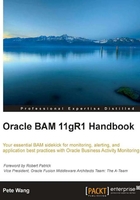
Conventions
In this book, you will find a number of styles of text that distinguish between different kinds of information. Here are some examples of these styles, and an explanation of their meaning.
Code words in text are shown as follows: " Let us look at a ChangeList example, which is produced by a ViewSet of the Employees Data Object."
A block of code is set as follows:
<ADCServerName>localhost</ADCServerName> <ADCServerPort>9001</ADCServerPort> <ICommand_Default_User_Name>user</ICommand_Default_User_Name> <ICommand_Default_Password>passwd</ICommand_Default_Password>
When we wish to draw your attention to a particular part of a code block, the relevant lines or items are set in bold:
<S:Envelope xmlns:S="http://schemas.xmlsoap.org/soap/envelope/">
<S:Header>
<work:WorkContext xmlns:work="http://oracle.com/weblogic/soap/workarea/">
rO0ABXdOABd3ZWJsb2dpYy5hcHAub3JhY2xlLWJhbQAAANYAAAA jd2VibG9naWMud29ya2FyZWEuU3RyaW5nV29ya0NvbnRleHQABjExLjEuMQAA
</work:WorkContext>
</S:Header>
<S:Body>
<ns2:InsertResponse xmlns:ns2="http://xmlns.oracle.com/bam"/>
</S:Body>
</S:Envelope>
Any command-line input or output is written as follows:
SOA_HOME/bam/bin/icommand.bat CMD IMPORT FILE <file name>
New terms and important words are shown in bold. Words that you see on the screen, in menus or dialog boxes for example, appear in the text like this: " Among them, Active Data Cache, Report Cache, and Report Server are the major components that are responsible for static and dynamic report rendering ".